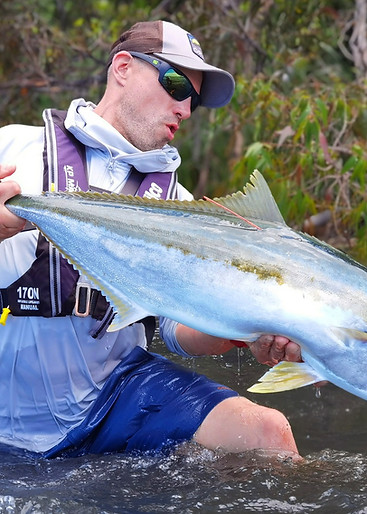top of page
New Zealand flaunts one of the finest saltwater fly fisheries in the world. Tauranga's expansive flats, and prevalence of large, shallow-going predators allow the fly fisher a visual experience like no other. This site shares information about this unique marine environment and the wonderful inhabitants within. Whether reading through or wanting to experience a guided saltwater fly fishing outing firsthand, I hope to leave you with a newfound set of eyes towards this incredible ecosystem.

Saltwater Fly Fishing New Zealand , Fly Fishing for Kingfish , Saltwater Fly Fishing NZ
-
What knots to use for saltwater fly-fishing ?I am nerdly passionate about experimenting and working with differant knots. It's a perpetually evolving learning journey, where definitive solutions are rare, and the satisfaction arises when a knot snugly settles and exhibits its strength. One key tip: ensure your knots are lubricated, manipulate them using your thumb and fingers – avoiding nails – and then cinch them tight. I use a knot-tightening tool for extra force and safeguard my fingers from sharp hook points. A vital realization is that knots aren't universally effective across all diameters. Generally, however, when linking the line directly to the hook, my go-to choices are the Trilene or Uni knots doubled through the hook eye. However, the most prevalent scenario involves the use of loop knots, specifically variations of the Lefty's Loop. Devoting time to mastering these knots pays off. Test their breaking points, hook it up to a fence and pull and build that confidence in your fishing setup
-
What hooks do you recommend for saltwater fly fishing?I am a passionate fly tier, but certainly don't claim to be a master at it. When selecting a fly hook, several factors come into play. The fly's purpose and the possibility of it being lost are my main considerations. My concern is the fish's well-being; I'm committed to preventing a discarded hook from troubling these fish. In situations where there's a likelihood of losing the fly or encountering break-offs, I opt for patterns tied on Gama katsu hooks. These hooks are designed to corrode over a span of days, minimizing potential harm to the fish. For more robust patterns that typically involve heavier tippet material, I lean towards the Ahrex series of hooks. These hooks are more durable, reducing the likelihood of corrosion and enabling multiple uses throughout the fishing season. To further ensure safety for both angler and fish, I make it a mandatory to pinch down all barbs. This measure underscores my commitment to responsible fishing practices and the well-being of the aquatic ecosystem.
-
What equipment is needed for saltwater fly-fishing?While sharing similarities in presentation and technique, freshwater and saltwater fly-fishing equipment diverges significantly due to the environments and target species. The corrosive and aggressive nature of the saltwater environment, home to robust, steroid-like fish, demands a departure from freshwater gear. Saltwater hooks are fortified to withstand larger adversaries and coated to resist corrosion. Ample backing is recommended as insurance against the formidable power and endurance of saltwater species. Unlike in freshwater, where the reel primarily holds the line, in saltwater, the reel becomes a critical component. Its larger diameter enables rapid line retrieval, crucial when up against fast fish on a 1:1 ratio reel. The drag system's complexity and lubrication are substantially increased to prevent the line and backing from being stripped away in mere seconds. While freshwater fly rods are nimble, their saltwater counterparts, normally 8 - 12 weights, pack a more robust punch. With various weights and actions, saltwater rod selection hinges on the angler's casting style and environmental factors, ensuring a successful pursuit of the ocean's formidable game fish.
-
Familiarizing yourself with saltwater fly fishing as a beginner?Exploring the world of saltwater fly fishing is a wonderful journey whether you're a beginner or a seasoned trout angler. As someone who entered from the trout angling side, I found the transition exhilarating – witnessing your backing vanish in a blur, feeling the forceful strike on the fly, and grappling with the power of these robust fish. It's an adventure that pushes the boundaries of your fly gear. The reality quickly dawns on many that their casting skills need refinement. With fast-moving fish and unpredictable winds assaulting from all directions, presentations demand a blend of power, precision, and speed. My top advice? Dedicate yourself to practicing your casting under all conditions. This effort will pay dividends when you're out on the water. Furthermore, immerse yourself in learning. Absorb insights from proficient anglers by reading and watching their techniques. Dive into podcasts that offer valuable wisdom – there are some exceptional ones like the Millhouse and Orvis podcasts. By continually honing your skills and absorbing knowledge, you'll equip yourself to thrive in the captivating world of saltwater fly fishing.
-
How to set up for saltwater fly-fishing?A one-size-fits-all approach to your setup falls short here in Tauranga due to the diversity of fish and their feeding behaviors. To do well, consider multiple setups tailored to specific scenarios. When aiming for kingfish around marker pylons or channel edges, reach for a 10 or 12 weight setup for that extra pulling power. For stealthy pursuits on the flats, the go-to is an 8# or 9# equipped with a floating or intermediate tip fly line and completed with a tapered leader down. This is useful for precise and delicate presentations, where finesse matters.
bottom of page

